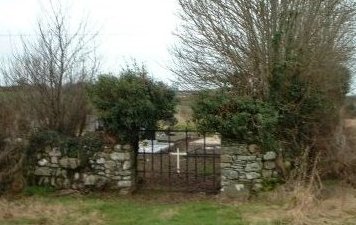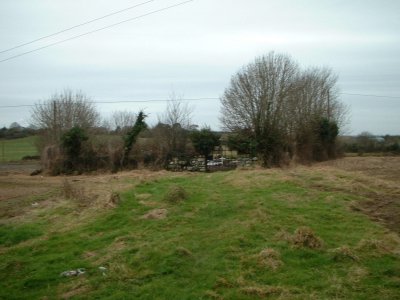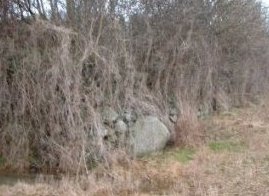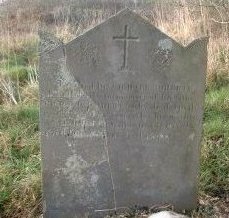|
Ballybrazil
Graveyard |
|

|
|
Entrance to
graveyard
|
|
Ballybrazil graveyard is about one
kilometre from Scoil Mhuire. It's a very ancient
religious site and is believed to be the oldest
graveyard in County Wexford. Nowadays Ballybrazil is a
townland but was once a parish in the Barony of
Shelburne. In the 1830's it had over 384 inhabitants. It
consisted of the townlands Ballybrazil, Aclare, Ballykerogue More, Ballysop, Coolerin
North and South,Curraghduff and Milltown. Before
Cromwell invaded in 1649 this land was owned by the
Suttons and consisted of 2,370 acres. It was later owned
by Rev.William Gifford who was the local landlord.
He lived in
Ballysop House and died in 1866.
|
|

View of graveyard from distance
|
The graveyard is
rectangular and is surrounded by a stone wall. It is very like
a ráth or ancient fort. It measures 94 metres by 86
metres. This enclosure also contained a church but only
the grass covered foundations can be made out. In
1837 when Samuel Lewis published his study of Co.
Wexford,Ballybrazil church was in ruins. A holy well,
dedicated to St.Crone, was nearby.
The site could also have had a fosse or moat
around it.
The graveyard can be entered
either by gate or stepping stones.
|
 
|
|
Stone
wall
Cross family headstones and
stone tablets.
|
|
In the 1850's Henry Cross
rented over 37 acres from Rev.Gifford at £21 per
year.He lived in Ballysop. Another headstone which is of
interest was erected by Michael Doherty of Ballykelly.
|
|

|
|
The inscription reads:
'Erected by Michael Doherty, Ballykelly, in memory of
his father Richard Doherty who died in 1861 and his
mother Anne, alias Glascott,who died in 1867 aged 78
years.' Richard Doherty,who lived in the townland of
Ballybrazil, rented over 25 acres at a rate of £18 per
year.
|
|
The Irish for
Ballybrazil is Baile Uí Bhreasáil. The name of the
original Irish owner of Ballybrazil was Ó Breasáil.
The translation is 'the townland of the son of
Brazil' and
we can see that Ó Breasáil must have been an important
and wealthy man to give his name to both the townland
and parish. When the Normans came they kept these same
names of the townlands and parishes and turned them into manors.
|
|
In the 1800's a small woollen mill was
to be found in Ballybrazil and provided welcome
employment. In 1798 the headquarters of
the rebel army was in Ballysop House which is closeby.
|
|
Please remember that this ancient
graveyard is still in use. Seán Crowley.
|
|
Please
Return to Local History
|

